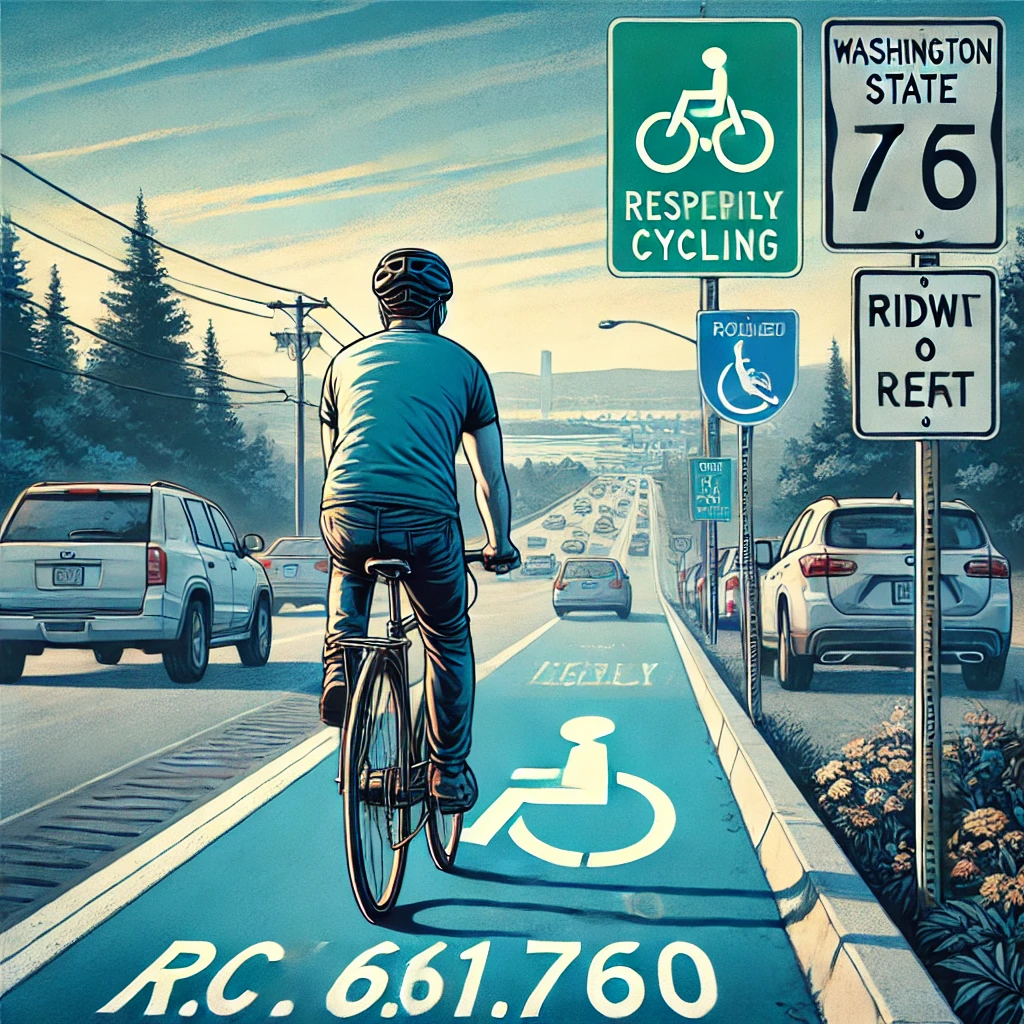Introduction: RCW 46.61.760 outlines the legal requirements for riding bicycles in Washington State. This statute is designed to ensure the safety of both bicyclists and others on the road by specifying how bicycles should be used. By adhering to these guidelines, cyclists can prevent accidents and avoid legal issues. This article explores the key provisions of RCW 46.61.760 and its implications for safe riding practices in Washington.
Key Provisions of RCW 46.61.760:
- Proper Riding Position (Subsection 1):
According to RCW 46.61.760(1), a person riding a bicycle must ride upon or astride a permanent and regular seat attached to the bicycle. This means that standing on the pedals or sitting on any part of the bike that is not the designated seat is prohibited. This rule is designed to ensure that riders maintain stability and control while riding, reducing the risk of accidents. - Carrying Passengers (Subsection 2):
The statute also prohibits carrying more persons on a bicycle than it is designed and equipped to accommodate. For instance, if a bicycle is built for one person, it cannot legally carry two riders. This rule is crucial for preventing accidents caused by overloading the bicycle, which can lead to loss of control and increased risk of injury.
Implications in Washington Law: RCW 46.61.760 is an important part of Washington’s traffic laws, aimed at promoting safe bicycle riding practices. Cyclists who adhere to these regulations are not only protecting themselves but also contributing to the overall safety of the roadways. Violating these rules can result in fines and, in the event of an accident, potential legal liability.
Safety Tips for Cyclists:
- Always ensure that you are seated properly on the bicycle’s designated seat while riding.
- Do not carry passengers on a bicycle unless it is specifically designed to do so.
- Be aware of your surroundings and follow all traffic laws to ensure a safe riding experience.
For more details on this statute, you can review the full text of RCW 46.61.760 here.
Conclusion: RCW 46.61.760 provides clear guidelines for safe bicycle riding practices in Washington State. By following these rules, cyclists can help ensure their safety and that of others on the road.
Additional Resources
- Understanding RCW 46.61.750: Regulations and Penalties for Bicyclists in Washington State Learn about the specific rules and penalties for bicyclists under Washington State law, designed to promote road safety and accountability among all users.
- Understanding RCW 46.61.765: The Dangers of Clinging to Vehicles in Washington State This article explores the risks and legal implications of “vehicle clinging,” explaining why it’s a prohibited activity and how it can endanger both the clinger and others on the road.
- Tragic Car Rollover Crash on Whidbey Island Leaves One Dead A detailed report on a fatal rollover accident on Whidbey Island, examining the potential causes and the legal rights of those affected by such tragic incidents.
- SR-18 Reopens After Deadly Crash Involving Semi, Bus, and Passenger Vehicle This article covers the aftermath of a deadly crash on SR-18, highlighting safety considerations for Washington drivers and the potential legal aspects of such cases.
- Tragic Teen Accident in Oak Harbor: Understanding Legal Rights and Responsibilities An examination of a tragic accident involving a teen, discussing the rights and responsibilities of involved parties and the legal guidance available to families.
- Washington Court System Outage: Updates and Impacts on Legal Proceedings Learn about a significant outage in Washington’s court system and its implications on legal processes, with advice for those impacted by the delays.
- Understanding RCW 46.61.100: Keep Right Except When Passing in Washington State A guide to the “keep right” law, detailing its importance for road safety and explaining when drivers in Washington must stay in the right lane.
- Highest DUI Rates and Their Impact on Road Safety This article explores regions with the highest DUI rates in Washington and discusses how these rates impact overall road safety, with insights into DUI prevention efforts.
- RCW 9A.16.020: Understanding When the Use of Force is Lawful A comprehensive look at Washington’s law on lawful use of force, detailing situations where force is justified and the legal boundaries for self-defense claims.
- Understanding RCW 46.61.765: The Dangers of Clinging to Vehicles in Washington State (Duplicate Article)An exploration of the duplicate link for RCW 46.61.765, detailing the dangers of vehicle clinging and the importance of legal compliance for road safety.
Additionally, explore our client resources here for more details on how we handle similar cases.
About Blanford Law:
At Blanford Law, we are committed to providing relentless, fair, and honest legal representation. With over 20 years of experience, Ken Blanford founded our firm on the belief that every client deserves respect and the best possible defense, free from assumptions or preconceived notions. If you or someone you know is facing criminal charges or has been injured due to someone else’s negligence, please contact us anytime at 253-720-9304 or email us at info@blanfordlaw.com.

